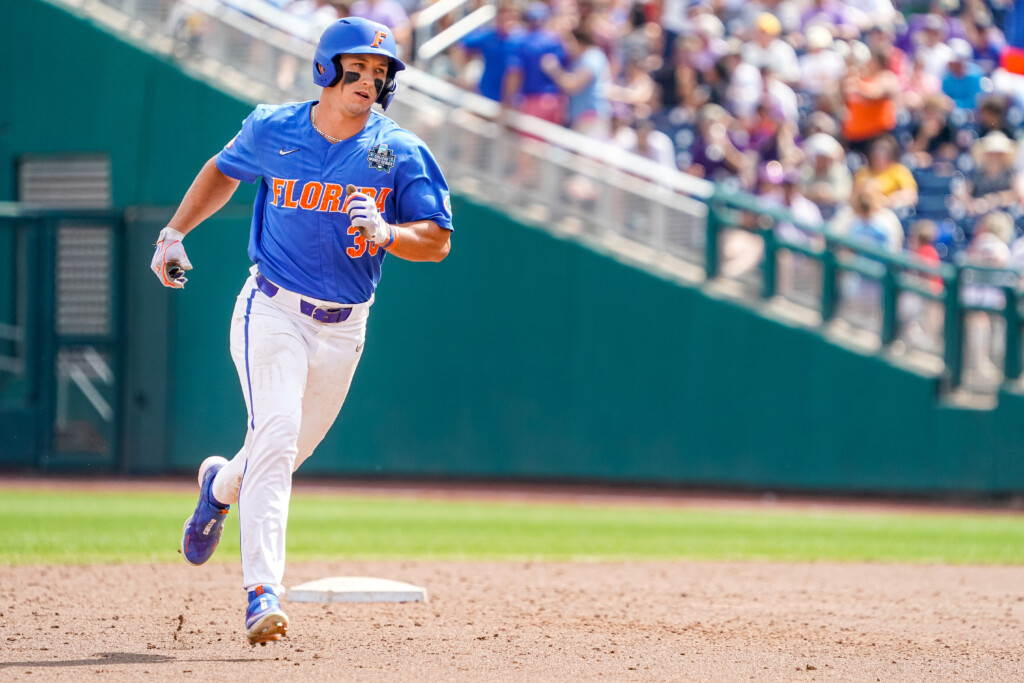The battle I usually fight (and lose) with my editor Mike Piellucci is the result of turning in twice as many words as I’m supposed to. So tasked with writing up my thoughts on the Rangers’ selection of University of Florida outfielder Wyatt Langford with the fourth pick in Sunday’s MLB Draft, I thought I’d balance things out with a two-word story.
Alas, I was reminded of D Magazine’s editorial standards, so here we are. While I’m allowed to point you to those two words—go; I’ll be here when you get back—Mike respectfully suggested that I come up with a few hundred more words (and one less expletive).
Incidentally, I issued that two-word reaction not when the Rangers called Langford’s name at 6:28 on Sunday night, but four minutes earlier when the Tigers chose Indiana high school outfielder Max Clark. And that’s because it gave the Rangers the opportunity to nab Langford. For weeks, consensus pointed to LSU teammates Paul Skenes and Dylan Crews as the first two players taken. And they were.
Yet when Baseball America released its final, day-of-the-draft mock, Langford was the SEC star projected to go first overall.
Veteran draft guru Jim Callis agreed in his. So did his MLB.com cohort Jonathan Mayo.
Plus Keith Law over at The Athletic.
And ESPN’s Kiley McDaniel, and FanGraphs’ Eric Longenhagen.
It was unexpected enough that the Rangers, who would have chosen seventh in every draft before this one, landed the fourth pick by virtue of the first MLB draft lottery. Picking the player whom every one of the most-established experts had going first overall felt like an extra nod from the baseball gods.
As Mike noted on Monday, Langford joins Evan Carter not only atop the Rangers’ prospect hierarchy but also in what was already a deep stable of young players who could help solidify the club’s big-league outfield picture, which is considerably less defined than the infield’s.
Langford has the pull power that was the one thing missing from Josh Jung’s profile when the Rangers took him with the eighth pick four years ago. He has the run tool that makes him a more complete prospect than Justin Foscue was when he was the 14th overall pick in 2020. He projects as a middle-of-the-order hitter, an enticing counterpart to the top-of-the-lineup profile that Carter offers. He plays with the fire that any team can use more of.
And as a hitter, Langford has a future that is more predictable than that of Jack Leiter, or Kumar Rocker, or just about any pitcher entering pro ball. The thought of Langford advancing through the Rangers’ system—and, as soon as spring training seven months from now on a non-roster invite, learning how Marcus Semien and Corey Seager put in their work—adds an exciting layer of optimism for the cycle the club has kickstarted.
Langford also theoretically gives GM Chris Young a little more comfort parting with a different frontline prospect on the trade market this month than he might have had if, say, he ended up with the seventh pick. That’s not a knock on Wake Forest righty Rhett Lowder, who went seventh to the Reds, or Corpus Christi-area catcher Blake Mitchell, whom the Royals took next. But Langford is in a different stratosphere. McDaniel, in fact, wrote last week that he’ll rank Langford as the No.9 prospect in baseball once he signs.
That doesn’t mean the Rangers wouldn’t have traded Owen White or Luisangel Acuna or Aaron Zavala had they not drafted Langford. But it sure feels like less of a dent in what the organization is building when all of those players are about to be shifted down a peg on the franchise’s asset sheet.
Let’s say, as I spitballed last week, that the Rangers and White Sox whittle trade conversations to the point at which Texas can get starting pitcher Dylan Cease and veteran relievers Kendall Graveman and one of Reynaldo Lopez or Keynan Middleton for White, Foscue, outfielder Bubba Thompson, and long reliever (and potential starter) Glenn Otto. (I am backing off my original Joe Kelly idea as the second reliever, as he has since come down with an elbow injury.) With Langford in place, the loss of one of the true power bats in the upper levels of the system would cause less heartburn, especially since Foscue, a second baseman who dabbles at third for a team with no foreseeable opportunities at either spot, is almost surely going to be traded by this winter. That would have been true without Langford, too. Now the focus shifts to trading him at the right time, with less worry about whether moving him would be a mistake.
Another trade idea I cooked up was reliever Brock Burke and three prospects (Triple-A left fielder/first baseman Dustin Harris, High-A pitcher Winston Santos, and High-A shortstop Maximo Acosta) to the Cubs for starter Kyle Hendricks and relievers Adbert Alzolay and Mark Leiter Jr. Harris could beat Carter and Zavala to the majors, but he’s behind them in terms of upside. Now he’s behind Langford, too.
When Langford arrives in the big leagues—some will dream of that happening in 2024, but 2025 is more realistic (and just fine)—he will be expected to inject thump and length into the lineup the way Jung has. But the possibilities he creates on the trade market mean he might have an impact in Arlington well before he takes his first major-league at-bat.
Author







